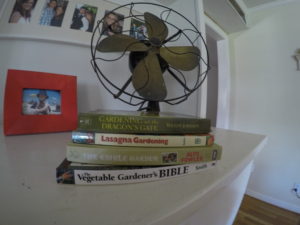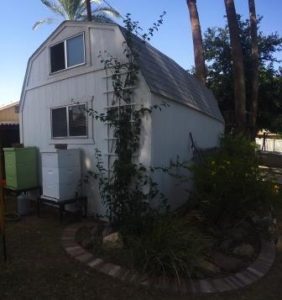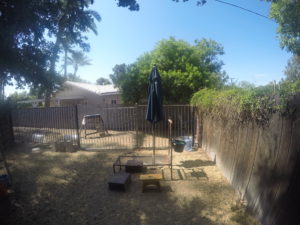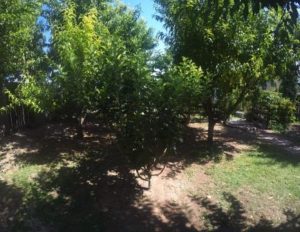Interview with Jill of Sweet Life Garden & Orchard (Phoenix, AZ) 2015-07-15
Jill describes how they acquired the land, its features, and how they did easy soil building using a technique called lasagna gardening. She also tells the story of her orchard, dairy goats, and selling products to their neighbors.
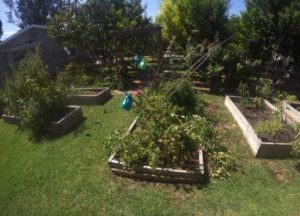 Jill will you tell us a little bit about the history of your garden and what you are growing and raising here at The Sweet Life Garden?
Jill will you tell us a little bit about the history of your garden and what you are growing and raising here at The Sweet Life Garden?
Our little urban farm here, it actually used to be my parents’ home and we bought it from them. It’s been years, but we’ve been here a long time. And this is my childhood home, too. When our kids grew up and we didn’t’ need all this space for running around or games, I felt like we have all this land and amazing flood irrigation. So I felt like it was our responsibility and privilege to share with our community and take advantage of our land. We have about ¾ of an acre. So the first year, we planted a peach tree. In about 2 years, we were harvesting the peaches.
We set out a little fruit stand, and we could not get the peaches out on the fruit stand fast enough. So we knew that there was a demand for fresh, organic fruit. People would come into my garden and say, “This is so beautiful. What else do you have available? I want to buy organic.” As time went on, we thought this is what our community wants. And so we started learning and researching, trying to figure out the best way to plant that would take advantage of our property.
How have you done soil building and garden construction?
We read Lasagna Gardening, and I like the way that Patricia Lanza wrote that book. Before, all of our gardens had been in the ground and we would dump stuff in there (and dump and dump and dump,) and then we would plant. But it would just dry out, and there would be all these weeds and it was just not productive. When I read her book, I thought this was a good way to do it and we started doing the layering method. Then we also did raised beds, which, for us were so much easier because you can contain your soil and you can control it. And it gives almost as much produce as just laying it out in the beds.
We started planting more fruit trees because the demand was high from our neighbors. But, it’s a lot of work because we have to prune all these trees. And then you have to harvest them. So it’s a lot of work.
Besides soil building, fruit trees and gardens, you also manage chickens, dairy goats, and bees.
It’s almost like we don’t need to go to the grocery store very often. And every time I go to the grocery store and look at the shelves, I think this stuff is gross; it’s like all processed stuff. We have the fresh eggs, we have milk from the goats, and also we do meat birds one time per year. Also, we have our organic chickens. We have the bees, so we’ll have the honey, too. It’s a good feeling to be sort of self-sustaining, and then also to share with the community.
How do you share with the community?
We share our garden with many neighbors and we also do garden tours so that we can inspire. I know that every time anybody comes into the garden and they don’t realize that you can grow things in Arizona as long as you amend the soil. Fruit trees grow like crazy here. Then they go home and are inspired start a garden of their own, or even just plant fruit trees. Most of my neighbors all have a fruit tree now.
I think if we can inspire people to start, I have a dream called Neighborhood Agriculture. If only 4 people in your neighborhood could have their own gardens and grow stuff, you could totally barter and trade, and provide for your neighborhood. So that’s one reason that we like to share, too, because we can teach people and we can share our experiences. That’s one of our goals as an urban farm.
That’s a great goal, and that’s one of our visions, as well, to have urban farms in every neighborhood. And if that means one person growing herbs, and one person growing fruit, and one person has eggs, and we share, then we’re a step ahead as a community, for sure. So what are some of your top tips for people who want to grow or raise food in the city?
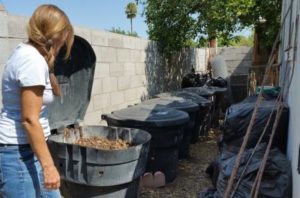 I think for Phoenix, since it’s so hot, the number one thing is soil building, to deep mulch. Don’t let your soil get dried out; the deeper the better. We have our barn litter that we use for soil building in our garden. In our chicken pen, we put straw to keep the flies down and absorb all of the poop in there. When we gather up the barn litter and clean up the chicken pen, we already have the nitrogen from the poop and the carbon from the straw.
I think for Phoenix, since it’s so hot, the number one thing is soil building, to deep mulch. Don’t let your soil get dried out; the deeper the better. We have our barn litter that we use for soil building in our garden. In our chicken pen, we put straw to keep the flies down and absorb all of the poop in there. When we gather up the barn litter and clean up the chicken pen, we already have the nitrogen from the poop and the carbon from the straw.
As we gather that up and bag it, we either compost it or put it straight into the garden beds, in which case we have to wait a little while so it’s not too hot (meaning too much nitrogen content that can damage plants.) The more you can layer on your leaves, or any kind of mulch, it keeps that soil nice and moist so that you don’t have to water as much. So I would say that deep mulching or deep composting right in your garden beds or boxes (is key.)
How do you water your gardens and trees?
I have flood irrigation here, so I get deep watering. But, as far as fruit trees (are concerned,) people don’t realize that you can’t just water the surface of the soil around your trees. You have to water 3 or 4 feet down so that the roots are reaching down into the soil and they’re not right on the surface. And mulching around your fruit trees will keep that (area) moist, too. Even with your vegetables, it’s just good to deep water those. If you deep water, you won’t have to water as frequently, which is good.
We talked earlier about starting small. You’ve got a lot of things going on here, but that didn’t happen overnight.
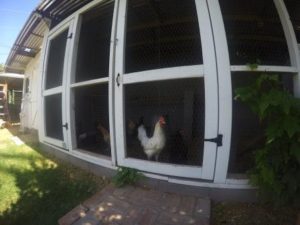 We’ve been doing this for 25 years, at least. And I didn’t really have a master plan or a big map to say I’m putting this here or this here. But we just started with one box. We just used pine, and we screwed it together and it was 3’X10’. I really like those skinny boxes because it’s just enough room for tomatoes or three rows of winter crops. And you can reach it all. And you can contain it and maintain it.
We’ve been doing this for 25 years, at least. And I didn’t really have a master plan or a big map to say I’m putting this here or this here. But we just started with one box. We just used pine, and we screwed it together and it was 3’X10’. I really like those skinny boxes because it’s just enough room for tomatoes or three rows of winter crops. And you can reach it all. And you can contain it and maintain it.
It just started with one bed. We did the lasagna gardening method and layered straw in there, and put the leaves, and then put compost and some soil in and mixed it all together. It was amazing, and we thought this is the way to do it. We started with one and saw that it worked. So we put another one next to it and did the same thing.
How did the farm grow?
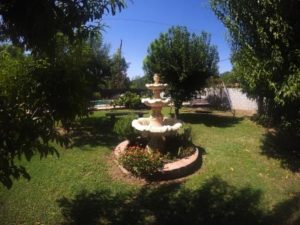 We started with one peach tree, a Desert Gold. We were amazed at the abundance of that, especially that you can just plant a tree, and as long as you water and prune it, it’s done! And you get so much fruit from those trees. So we started researching trees and the best varieties for our area and for our chill hours here. Hal and I added trees everywhere we could, so it’s kind of a crazy farm!
We started with one peach tree, a Desert Gold. We were amazed at the abundance of that, especially that you can just plant a tree, and as long as you water and prune it, it’s done! And you get so much fruit from those trees. So we started researching trees and the best varieties for our area and for our chill hours here. Hal and I added trees everywhere we could, so it’s kind of a crazy farm!
But then we just kept adding beds. We would clean out areas of our property and say okay, we could put three more here. So just a little at a time, we added a couple of boxes every year until now it’s kind of covered. We have no more places to add anything.
It’s beautiful. It’s like a food oasis on your property. And one thing I wanted to touch on is for you to tell us about your goats and where they live on your property. It’s quite interesting.
Our property is on a corner lot, and we have a couple of alleys behind us on both sides. They’re abandoned alleys, so utilities or garbage trucks aren’t going down there. So, we went to all of our neighbors, especially the one right next to us and down the side alley. We went to every neighbor and said that we want to have chickens and goats here, and would you mind. We told them that they would make noise, but we got it Okay-ed with everybody. They were really excited about it, actually.
The people next door had just moved in, and I’m sure they just thought that we were a little weird. But we put a gate at both ends of alley. You’ve got to have access back there. So we have the gates, but we can open them if we need to, because when it’s irrigation time, people need to go through there. (It’s an easement for the city.) We can open them back up, and they are not permanent gates. When we need to open up the alleyway, we bring the goats back up onto our property.
They love it, and they keep the overgrown grass and weeds in the alley (under control.) If they don’t eat them, they stomp them down. They spend most of their time back there under the shade of the alley and roam around back there. So, that provides them with a lot more property than we have here. And the other thing is that peach tree leaves are poisonous to goats, so we have to make sure that they don’t get into the orchard areas. So we keep them back there, and it’s safer for them and moves them around the property.
Well, it’s a great, creative way to use the property and have a farm in the city where we’re more limited than people who live out in the country. Tell us a little bit about your goat varieties.
Since we’re in the city and we have neighbors right on the other side of the fence, we have La Manchas which are known for being quiet. There are Nubians, which are known for being really loud and noisy and boisterous. And their noises carry a long way, because we tried those…
We also have Nigerian dwarf goats, and they’re pretty quiet, too. When we get our animals, we want to make sure that we’re not disturbing our neighbors too much. There are times when they are hungry or ready to be milked when they’ll make noise. But, we like La Manchas. They’re the ones that have no ears, so they’re funny looking. But they’re really quiet and perfect for a backyard stable.
How big do they get?
Actually, ours are mini La Manchas, so these are smaller (than Nubians for full size La Manchas.) We do the dwarf and the mini varieties. We have a mini Nubian, too. She’s new and she’s really loud, so I’m always saying, “Nellie, be quiet.” So that’s why we try to stick with the La Manchas, and you don’t have to breed them every year. You can just keep milking them for at least two years without (freshening them every year.)
How often do you milk?

I only milk once a day, in the morning. I used to milk morning and late afternoon. And it was just too much. I couldn’t go anywhere. I was saying to one of my friends, Lylah from The Simple Farm, that these goats are a lot of work. You have to get up in the morning and make sure you milk them. You can’t let them go (too long.) And we were milking them in the evening, too. We just couldn’t go anywhere; or if we went somewhere, we had to hurry and get back.
So Lylah said to just do the morning time. That’s plenty of milk for us, and we actually have milk left over. I have milk in the freezer. So it’s once in the morning, and we only have two goats in milk right now. That’s enough for our family. I don’t think I would get any more goats. It’s enough time, and it’s enough milk for us.
I thank you so much for your tips and for sharing your story with us today, Jill.
- To learn more about building raised bed gardens and using the lasagna gardening method, visit Jill’s web tutorial, Gardening in a Box.
- Purchase Patricia Lanza’s book, Lasagna Gardening, here.
- Watch a video tour of the garden here.

